Emissions from major fossil fuel and cement producers have been directly linked to significantly intensifying heatwaves globally, according to a groundbreaking study published in Nature. This research reveals that since the pre-industrial era, these emissions have made an average heatwave approximately 50 per cent more intense. The study analysed 213 heatwaves recorded between 2000 and 2023 from the international 'Emergency Events Database,' including the devastating 2022 heatwave in India, underscoring the broad geographic impact of rising temperatures.
The research team, comprising European experts including those from ETH Zurich, employed an attribution approach, a method designed to quantify how much human-driven climate change influences specific extreme weather events. Their findings indicate that emissions from 180 major carbon-emitting entities—comprising fossil fuel companies such as Saudi Aramco, Russia's Gazprom, Chevron, and coal-reliant nations like China and India—substantially contributed to the increased likelihood and intensity of all 213 heatwaves studied. The carbon majors are estimated to be responsible for around 57 per cent of all carbon dioxide emissions since 1850, a major driver behind global warming and the observed surge in extreme weather.
Significantly, the study estimates that roughly a quarter of these heatwave events would have been virtually impossible without the influence of human-caused climate change. The researchers highlight that climate change made typical heatwaves 20 times more likely during 2000-2009, and about 200 times more likely during 2010-2019, reflecting a rapidly escalating risk. Furthermore, individual carbon majors’ emissions were linked to enabling between 16 and 53 heatwaves that would not have occurred in a pre-industrial climate, suggesting that even smaller emitters play a considerable role.
This research adds to the mounting evidence that state-owned and investor-owned fossil fuel producers collectively bear significant responsibility for today’s climate crisis. According to data from the Carbon Majors database, 36 fossil fuel and cement producers account for more than half of the world’s greenhouse gas emissions in 2023. State-owned companies such as Saudi Aramco, Coal India, CHN Energy, the National Iranian Oil Company, and Jinneng Group contribute to nearly a fifth of these emissions, posing distinct challenges for regulatory accountability compared to private firms like ExxonMobil and Chevron.
Experts emphasise that such attribution studies are increasingly crucial, not only for understanding the escalating impact of climate change on extreme weather but also for holding specific companies and sectors accountable. Traditionally, studies focused on global or national emissions, but this research brings an unprecedented focus on individual emitters’ contributions to deadly heatwaves worldwide. The intensification of heatwaves—from Europe to Asia—spotlights the urgent need for comprehensive climate action and corporate responsibility to mitigate further harm.
In light of these findings, policymakers face renewed pressure to address emissions from the largest carbon producers, both state-backed and private, to curb the accelerating frequency and severity of heatwaves that threaten lives and ecosystems globally.
📌 Reference Map:
- Paragraph 1 – [1], [7]
- Paragraph 2 – [1], [2], [3]
- Paragraph 3 – [1], [2], [3], [5]
- Paragraph 4 – [6]
- Paragraph 5 – [1], [2], [3], [4]
Source: Noah Wire Services
